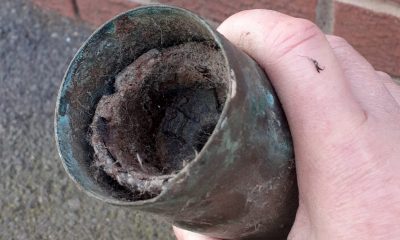Research reveals how humans are changing the way life evolves
Humans are profoundly transforming their surroundings - which is dramatically impacting organisms they share them with.
Published
2 years ago on
By Mark Waghorn via SWNS
Humans are changing the way life evolves as plants and animals adapt in unusual ways because of us, according to new research.
The phenomenon - dubbed "unnatural selection" - is one of the greatest biological forces on Earth.
It has created "parallel urban worlds" where wildlife has had to respond - or die.
Co-lead author James Santangelo, a PhD student at the University of Toronto, explained: "We have long known we have changed cities in pretty profound ways.
"We have dramatically altered the environment and ecosystems.
"But we just showed this happens, often in similar ways, on a global scale."
The finding is based on an analysis of white clover collected from 160 cities and nearby rural areas in 26 countries.
A familiar weed of British gardens, it is famous for its three trefoil leaves.
It provides the clearest evidence to date that people in towns and cities are driving nature.
The shamrock plant is genetically altering from London to Lisbon, Toronto to Tokyo and Melbourne to Munich.
Humans are profoundly transforming their surroundings - which is dramatically impacting organisms they share them with.
The Global Urban Evolution Project (GLUE) study showed conditions tend to be more like each other than nearby rural habitats.
So downtown Toronto is more comparable to downtown Tokyo than to farmland and forests just outside the city.
For instance, white clover produces hydrogen cyanide to deter herbivores and increase tolerance to drought.
The international team found city varieties produce less due to changes in the presence of plant eaters and water stress.
It applies across different climates - and the implications reach far beyond the humble clover.
Co-lead author Dr. Rob Ness, also from Toronto, said: "This study is a model to understand how humans change the evolution of life around us.
"Cities are where people live, and this is the most compelling evidence we have that we are altering the evolution of life in them.
"Beyond ecologists and evolutionary biologists, this is going to be important for society."
White clover is present in almost every city - providing the perfect tool to investigate human influence on evolution.
It began with the domestication of dogs 30,000 years ago. Now industrialized farming, introduced species, urbanization, pollution and climate change are creating unprecedented selective pressures.
Evolution - at least for larger, more complex organisms - can be slow. It leaves many animals unable to adapt fast enough.
But rapid change is also possible, via an inbuilt genomic plasticity. The most famous example is the peppered moth.
It changed from speckled white to black in response to soot and air pollution rising from the chimneys of the Industrial Revolution in Britain.
Today, worker bees in industrial beehives - transported from farm to farm across the United States in convoys of trucks - are one-third larger than their wild cousins, and more docile.
In the past 100 years, North American songbirds have modified the shape of their wings to cope with habitats fragmented by deforestation.
Under pressure from poaching, Zambian elephants are born without tusks.
Since the introduction of cane toads to Australia in 1935 to deal with beetle infestations in sugar plantations, the mouths of black snakes have shrunk.
Succeeding generations learned to avoid toad-sized prey, while the toads themselves have become cannibals, victims of their own success as predators.
Sea-snakes in Papua New Guinea have developed darker bodies and shed their skins more often in response to toxins in the zinc-polluted waters they inhabit.
One species of mosquito has evolved to live only in the tunnels of the London Underground, and lost the capacity to breed with its surface-dwelling cousins.
Similar declines in genetic diversity have been observed in mosquitoes in the New York and Chicago subway systems.
Blackcaps have shifted their migration routes from the Iberian Peninsula to the UK as climate change extends their range.
Swans that avoid cities have a genetic difference from the ones that are human-tolerant.
The study in the journal Science opens the door to developing strategies to conserve rare species in towns and cities.
It can also help us better understand how to prevent unwanted pests and diseases.
The 287 scientists have sequenced more than 2,500 clover genomes from over 110,000 samples.
They have created a massive dataset that will be studied for years to come. The unprecedented initiative began with a single Tweet.
Added co-lead author Prof Marc Johnson, also from Toronto: "Nearly everyone we asked to collaborate said yes - and that was kind of remarkable, because we were asking people to take on a lot of work,.
"Our collaborators recognized the importance of this project. There has never been a field study of evolution of this scale, or a global study of how urbanization influences evolution.
"It would have been impossible to do this without our global set of collaborators."
Stories and infographics by ‘Talker Research’ are available to download & ready to use. Stories and videos by ‘Talker News’ are managed by SWNS. To license content for editorial or commercial use and to see the full scope of SWNS content, please email [email protected] or submit an inquiry via our contact form.
You may like


Metals can heal themselves just like ‘The Terminator’


Two-faced star has hydrogen on one side and helium on other


World’s oldest big game hunting weapon found


An espresso a day could keep Alzheimer’s at bay


Being bipolar significantly raises risk of premature death: study


Soccer players who regularly use head more likely to develop Alzheimer’s
Other Stories


New breakthrough treatment boosts cancer-fighting cells
The approach involves activating the immune cells in the body and "reprogramming" them to attack and destroy the cancer cells.


One-year-old can’t stop laughing during first ride at Disneyland
"We didn't expect him to love it that much."


Dad running marathon wearing chainmail weighing over 40 pounds
A dad is attempting to break the world record for the fastest marathon while wearing chainmail.


Hero saves elderly couple by dragging them out of burning car
The Good Samaritan jumped into action after spotting the fire on his way to work.


Bomb squad seals off town after ammunition shell donated to charity shop
Staff discovered the device in a bag of donations.
Top Talkers

 Parenting2 days ago
Parenting2 days agoSingle mom details struggles of feeding her 12 kids

 Broadcast4 days ago
Broadcast4 days agoOver 40% of Americans have no clue what a 401k is

 Broadcast3 days ago
Broadcast3 days agoHow hard is it for Americans to live sustainably?

 Broadcast1 week ago
Broadcast1 week agoGrocery shopping hungry is costing Americans this much

 Funny1 week ago
Funny1 week agoCops confused by crow mimicking police siren

 Shopping1 week ago
Shopping1 week agoGrocery shopping hungry costs Americans this much every trip

 Money4 days ago
Money4 days agoOver 40% of Americans have no clue what a 401k is

 Parenting1 week ago
Parenting1 week agoIt takes this many minutes for the average American kid to get bored
